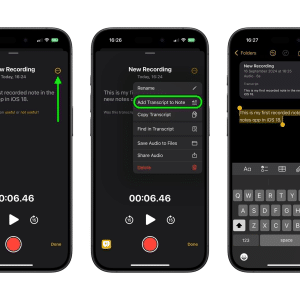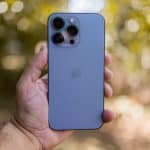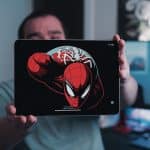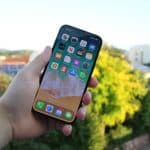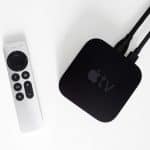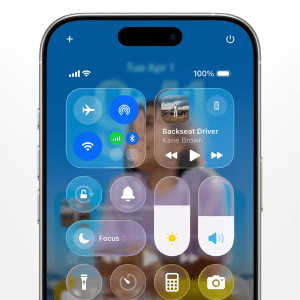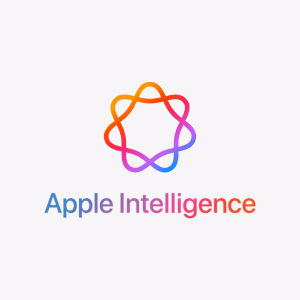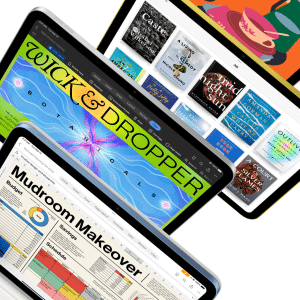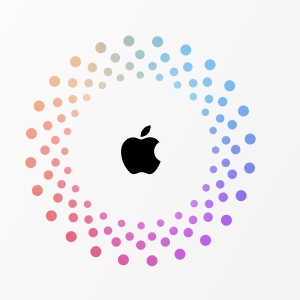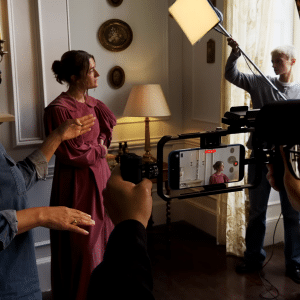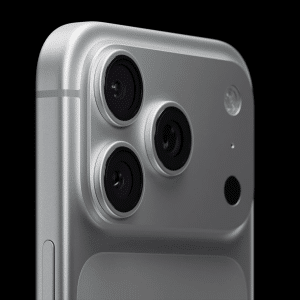
Tablets in Higher Education Since the March 2010 release of the iPad, the mobile tablets have been touted as magical tools full of educational promise in Apple commercials and print advertisements. A 2011 Apple commercial entitled “Learn” shows the iPad being used to watch a TED talk, to practice writing in Chinese, to look up the definition of a word, to investigate human anatomy, to explore astronomy, to play chess and the piano. The thirty-second commercial ends with the narrator stating, “There’s never been a better time to learn.”1 In large letters on the Apple iPad Education web page, the company declares, “The device that changed everything is now changing the classroom.”2 Many colleges and universities implemented programs to explore the value of these devices in a higher education landscape. According to a 2011 press release from comScore, the iPad accounts for 97 percent of all tablet-based Web traffic in the United States and 46.8 percent of all mobile Web traffic.
The iPad is a multipurpose mobile computing device. The ability to read electronic texts, in particular, makes the iPad an attractive device for colleges and universities. With the average cost of a print textbook significantly higher than that of its electronic counterpart, the e-reading potential of the iPad is not lost on students, faculty, librarians, and higher education administrators. Researchers studying the iPad have found that one of its most beneficial uses is its function as an e-reader or alternative to print textbook.4 The 201 1 Horizon Report further states that devices like the iPad and Samsung Galaxy represent a new class of tools merging the utility of e-readers with web browsing, a wide variety of applications, and more. With these new tools, publishers are creating new kinds of reading experiences, incorporating richly visual interfaces that include multimedia and collaborative elements.
Beyond e-reading, many in higher education are experimenting with using iPads for teaching and learning. Famously, Abilene Christian University (ACU), known for providing each student with a mobile device starting in 2008, has sought to explore the value of mobile devices and iPads through its Mobile Learning Initiative.6 Since 2009, ACU has empowered faculty to research mobile technologies through a mobile learning fellowship program. Several studies focused on the iPad as the object of intervention. Researchers investigating the efficacy of iPads in a paperless classroom asserted that the iPad is a true mobile learning device, not simply a novelty.7 In a study of faculty use of iPads at the University of San Francisco, researchers gave forty faculty members, including a librarian, an iPad 1 and surveyed the participants’ opinions on the use of iPads in higher education. Participants reported that the iPad had value, although it was limited in its functionality; moreover, they called for similar research to be done with students.
Case Study
Indiana University-Purdue University Indianapolis (IUPUI), Indiana’s urban research institution, was founded in 1969 as a partnership of Indiana University, Purdue University, and the city of Indianapolis. IUPUI is Indiana’s third-largest university with a combined undergraduate and graduate student enrollment of approximately 30,000. Built on the strength of Indiana University and Purdue University, IUPUI offers a distinctive range of bachelor’s, master’s, professional, and PhD degrees in more than 225 majors across twenty-one schools. Indiana University is the managing partner of IUPUI.
In the fall of 2010, the University Information Technology Services (ULTS) of Indiana University established three iPad Faculty Learning Communities (FLCs) to explore how the iPad could enhance teaching and learning. Two FLCs were located at IUPUI: (1) an eight- member interdisciplinary FLC with faculty from the Purdue School of Engineering and Technology, the IU School of Liberal Arts, the IU School of Physical Education and Tourism Management, Herron School of Art, and University Library; and (2) an eight-member Health Sciences FLC with faculty from the IU School of Health and Rehabilitation Sciences, the IU School of Medicine, and the IU School of Social Work. Each member of a FLC received a 16 GB iPad 1 with Wi-Fi and access to a classroom kit with up to forty of the same iPads for classroom use. The groups met every two weeks to discuss instructional activities, research, and other experiences using iPads.
This report is a case study of the interdisciplinary IUPUI iPad FLC, revealing ways in which faculty used iPads to create new transformative teaching and learning experiences. These examples represent a variety of disciplines and approaches to integrating iPads into instruction, which could prove useful to those considering an iPad program or instruction with mobile tablets and devices.
Music
E. J. Choe, assistant professor of music and arts technology, employed the iPads in her first- and secondyear musicianship courses. The iPad is a useful tool for students of music when used as an e-reader for sheet music with apps like SheetRack; however, more significantly for Choe, it functions as an engaging ear- training tool. Ear training is an important skill for musicians as it empowers one to aurally identify pitches, intervals, melody, chords, rhythms, and other fundamental elements of music. Choe uses the apps Step and a Half, Relative Pitch, Karajan, Ear Training, and Virtuoso to improve this skill for her music students.9 Using the iPads, students no longer need to be in a listening lab with keyboard and computer workstation equipped with ear-training software. Also, with iPads, students had the flexibility of working on their ear training whenever they wanted instead of using the lab with limited hours of fifteen to twenty hours a week. The iPad mediates the divide between student and instrument, enabling learning in a mobile environment.
Organizational Leadership and Supervision
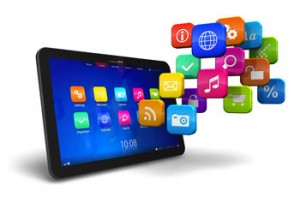 In the department of Computer, Information, and Leadership Technology, Organizational Leadership and Supervision program, clinical assistant professor Timothy Diemer explored the potential of the iPad as the delivery vehicle for a fully online class. The effort included development of open source learning modules that could augment and eventually replace the standard textbook.10 The largely text-based learning modules were designed to capitalize on the multimedia capability of iPad by embedding links to online resources including video. The courseware that Diemer employed enables interactive learning with audio and video conferencing. However, the iPad versions of the software were not fully functional at the time of the implementation.
In the department of Computer, Information, and Leadership Technology, Organizational Leadership and Supervision program, clinical assistant professor Timothy Diemer explored the potential of the iPad as the delivery vehicle for a fully online class. The effort included development of open source learning modules that could augment and eventually replace the standard textbook.10 The largely text-based learning modules were designed to capitalize on the multimedia capability of iPad by embedding links to online resources including video. The courseware that Diemer employed enables interactive learning with audio and video conferencing. However, the iPad versions of the software were not fully functional at the time of the implementation.
Use of an iPad primarily as an e-reader, as in this example, taps only a small part of its potential, limiting the iPad to a consumption rather than a production device. In order for iPads to be more widely adopted in higher education, the device must transcend information consumption and show its potential as a producer of the artifacts of learning.
English
Suzan Stamper, senior lecturer in English, uses iPads in an English for Academic Purposes course to help English as a second language (ESL) students develop their academic communication skills in English.11 The iPads gives Stamper the opportunity to improve upon existing practices of ESL instruction. Using the Flashcards app, Stamper is able to create flash cards with five sides; further, she can include multimedia figures in the cards using the rich graphic display on the iPad. To a greater degree, Stamper uses the iPad and Google Docs forms with students to encourage self- assessment and confidence building in language learning. In these iPad activities, Stamper adapts Google Docs forms into reading and grammar activities for guessing vocabulary in context, noticing parts of speech, and identifying pronoun reference.12 By utilizing downloaded applications and native web browsing, Stamper employs the iPad to create new learning experiences and reduce the need for traditional computers.
Communication Studies
In teaching communication theory, Jonathan Rossing, assistant professor of communication studies, capitalizes on the collaborative, mobile computing on the iPad. Rossing has students apply communication theory to current events, common scenarios, and familiar problems using a concept-mapping app, Popplet, and Safari for web browsing. In groups, students explain a theory on a collaborative Popplet board using individual iPads, and then they relate it to real-world examples by taking Screenshots of items found by searching the Web.
In addition, Rossing directs each group to use Twitter to engage in a class discussion about process, theory, and society. Through this directed use, the iPad is a tool for the consumption, production, and discussion of knowledge.
Rossing is aware that the activities in which students are engaging (concept mapping, web surfing, social media) are not specific to the iPad or even mobile devices. He states, “Instead of skills associated with specific technologies, students need to develop adaptable performance skills and artful, critical thinking that will prove valuable for future technological contexts and transformations.”14 The value of presenting these activities on an iPad is interconnected to the importance of technological knowledge and professional competency. Physical Education
For Jake Streepey, associate professor of kinesiology, the iPad is a mobile laboratory. In his biomechanics course, students use iPads and selected applications (xSensor, Accelerometer Data Pro, OmniGS, and Video Physics) to perform basic movement analysis.15 Using applications that access data from the iPad’s native accelerometers (the sensors that change the iPad’s display layout from portrait to landscape when the device is turned), students could view, record, and plot body accelerations when the iPad was held close. While holding the iPad (see figure 9.2), the students performed simple tasks such as standing up from a chair while the iPad tracked body acceleration. Students could also import video into the iPad and use that video to quantitatively examine how a particular body part or body segment moved during more sophisticated movements such as diving into a pool or shooting a jump-shot. Not only do these activities reinforce course concepts, but they also give students low-cost, accessible alternatives for examining movement performance.
The students are shown that common mobile technology can be conveniently used in the field (rather than in a specifically designed laboratory) to assess changes in movement occurring as a consequence of coaching, training, or rehabilitation. With lab space on college campuses in high demand, the iPad emerges as a solution by enabling professors to create mobile labs in any classroom.
Tourism Management
 Amanda Cecil, associate professor of tourism management, uses iPads in her global tourism seminar to give groups an opportunity to develop presentations. Using the apps iBrainstorm and Popplet, Cecil directs small groups to visually represent their information needs, find sources, and import graphics. Moreover, Popplet allows students to work on a collaborative digital board, allowing each student to have an iPad while working as a group. The benefit of using the iPad is that it offers a unique way to organize thoughts and connect ideas and concepts.16 In this case, the iPad does not create a new activity (concept mapping); however, it reinvigorates the activity with rich media and lasting digital artifacts. The artifacts, in turn, are thereby available for students to incorporate in class group presentations using PowerPoint, Prezi, or other online resources.
Amanda Cecil, associate professor of tourism management, uses iPads in her global tourism seminar to give groups an opportunity to develop presentations. Using the apps iBrainstorm and Popplet, Cecil directs small groups to visually represent their information needs, find sources, and import graphics. Moreover, Popplet allows students to work on a collaborative digital board, allowing each student to have an iPad while working as a group. The benefit of using the iPad is that it offers a unique way to organize thoughts and connect ideas and concepts.16 In this case, the iPad does not create a new activity (concept mapping); however, it reinvigorates the activity with rich media and lasting digital artifacts. The artifacts, in turn, are thereby available for students to incorporate in class group presentations using PowerPoint, Prezi, or other online resources.
University Library (Journalism)
In my role as assistant librarian, subject liaison to the IU School of Journalism, I used iPads to execute information literacy activities in a one-shot instruction session. After a lecture on finding information and evaluating it for credibility, I gave students in a computer methods for journalism course each an iPad and broke them into groups. Using the information delivered in the lecture, students had to use news apps (NPR, USA Today, and New York Times), the library mobile website, and web browsing using Safari to find materials related to a topic. Once groups found this information, they posted it to a collaborative Popplet board (figure 9.3) and discussed the credibility of the retrieved information.
Mobile website of lUPUl University Library
Without a traditional computer lab, iPads served as an information-retrieval tool, allowing students to practice information seeking and evaluation. Though not as robust as an exercise using traditional computers, the activity with the iPads allowed students to improve skills with the added benefit of teaching information seeking in a mobile environment.
What Is Popplet?
Popplet is a collaborative concept-mapping app developed by Notion. Many of the members of the IUPUI PLC used Popplet for group activities. The app allows groups to work on individual devices while contributing to a shared digital concept map. Using the app, learners can add text, pictures, and URLs to create a multimedia representation of thoughts, a presentation, or notes. Popplet allows students to send their completed concept map, or Popplet board, in PDF or JPG format. In addition, there is a companion online version of Popplet that allows users to insert video into a Popplet board and create permanent links to online boards. We used Popplet often because of its relative ease of use, ability to capture student work in multiple forms, and collaborative features. Activities using iPads can be challenging to plan since many apps are not designed with grading, exporting, or e-mailing features.
iPad Study
The faculty in the interdisciplinary IUPUI FLC completed a study of the students’ perceptions of their learning and engagement using iPads in class. This research furthered the published knowledge on iPads being used in higher education by focusing on students and their learning experience with the devices, rather than faculty or specific activities using iPads.17
Following the final class session using iPads, students were asked to complete a twelve-item questionnaire with both Likert- scale and open-ended questions relevant to the perceived learning and classroom engagement with iPads (tables 9.1 and 9.2).18 In addition, students were asked to answer demographic questions and questions related to their knowledge and comfort with instructional technologies. Over the spring 2011 semester, 209 students in nine courses participated.
Overall, students agreed that the iPad contributed to their learning (table 9.1) and engagement (table 9.2) on a five-point Likert scale ranging from Strongly Agree (5) to Strongly Disagree (1). (Note: the variance of p is a result of students choosing not to answer questions.)19 The qualitative data provide deeper insight into the students’ perception of the learning experiences with iPads. One respondent stated that iPads allow one to “easily access information. Groups can produce more work quicker and eases group cohesiveness.” Considering the physical characteristics of iPads, a student reported, “It was convenient and fun. . . . The portability of them made it easier to discuss with the professor.” Another student stated that “using the iPads was a ‘fun’ way to learn something that’s useful towards our degree.”
Students also reported on the negative aspects of bringing the iPad into classroom experience. Several students expressed the view “time wasted when the iPad wasn’t working properly.” Moreover, a number of respondents related that the iPad was distracting. For example, “I found myself want[ing] to play with the apps or search the web rather than focus on course material.” A student added, “[people] can get lost in the iPad and not focus on group work.” Further, a student unfamiliar with the technology stated, “I don’t know how to effectively use the iPad. I probably won’t ever buy one, so I am not that interested in learning to use one.” Overall, students responded favorably to iPad activities, but their criticisms provide caution.
The newness of iPad, its design, and its intimidation potential can befuddle any learning activity. By focusing on student perceptions of learning and engagement, this study contributes understanding of students’ experience using iPads in class. Yet, further study on iPads and students is needed to assess the achievement of specific learning outcomes compared to those in courses or activities excluding iPads.
Conclusion
Not without faults, iPads and other mobile devices are making significant change to the higher education landscape. The 2011 EC AR National Study of Undergraduate Students and Information Technology from EDUCAUSE found that 8 percent of students own iPads, 12 percent own e-readers, and 55 percent own smartphones.20 With these numbers growing every year, it would be irresponsible for librarians, faculty, and administrators to ignore the ways in which the mobile environment is changing teaching, learning, and professional expectations of students. Faculty and librarians are charged with finding ways to use these devices to contribute to learning.
Library Technology Reports




